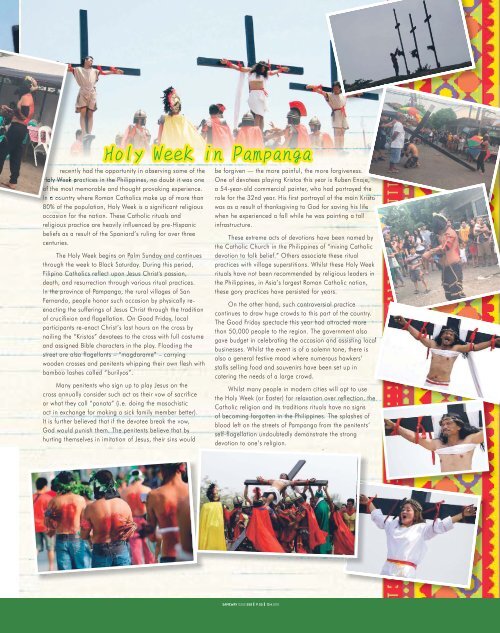You also want an ePaper? Increase the reach of your titles
YUMPU automatically turns print PDFs into web optimized ePapers that Google loves.
I recently had the opportunity in observing some of the<br />
Holy Week practices in the Philippines, no doubt it was one<br />
of the most memorable and thought provoking experience.<br />
In a country where Roman Catholics make up of more than<br />
80% of the<br />
population, Holy Week is a significant religious<br />
occasion for the nation. These Catholic rituals and<br />
religious practice are heavily influenced by pre-Hispanic<br />
beliefs as a result of the Spaniard’s ruling for over three<br />
centuries.<br />
The Holy Week begins on Palm Sunday and continues<br />
through the week to Black Saturday. During this period,<br />
Filipino Catholics reflect upon Jesus Christ's passion,<br />
death, and resurrection through various ritual practices.<br />
In the province of Pampanga, the rural villages of San<br />
Fernando, people honor such occasion by physically reenacting<br />
the sufferings of Jesus Christ through the tradition<br />
of crucifixion and flagellation. On Good Friday, local<br />
participants re-enact Christ’s last hours on the cross by<br />
nailing the “Kristos” devotees to the cross with full costume<br />
and assigned Bible characters in the play. Flooding the<br />
street are also flagellants – “magdarame” – carrying<br />
wooden crosses and penitents whipping their own flesh with<br />
bamboo lashes called “burilyos”.<br />
Many penitents who sign up to play Jesus on the<br />
cross annually consider such act as their vow of sacrifice<br />
or what they call “panata” (i.e. doing the masochistic<br />
act in exchange for making a sick family member better).<br />
It is further believed that if the devotee break the vow,<br />
God would punish them. The penitents believe that by<br />
hurting themselves in imitation of Jesus, their sins would<br />
be forgiven — the more painful, the more forgiveness.<br />
One of devotees playing Kristos this year is Ruben Enaje,<br />
a 54-year-old commercial painter, who had portrayed the<br />
role for the 32nd year. His first portrayal of the main Kristo<br />
was as a result of thanksgiving to God for saving his life<br />
when he experienced a fall while he was painting a tall<br />
infrastructure.<br />
These extreme acts of devotions have been named by<br />
the Catholic Church in the Philippines of “mixing Catholic<br />
devotion to folk belief.” Others associate these ritual<br />
practices with village superstitions. Whilst these Holy Week<br />
rituals have not been recommended by religious leaders in<br />
the Philippines, in Asia’s largest Roman Catholic nation,<br />
these gory practices have persisted for years.<br />
On the other hand, such controversial practice<br />
continues to draw huge crowds to this part of the country.<br />
The Good Friday spectacle this year had attracted more<br />
than 50,000 people to the region. The government also<br />
gave budget in celebrating the occasion and assisting local l<br />
businesses. Whilst the event is of a solemn tone, there is<br />
also a general festive mood where numerous hawkers’<br />
stalls selling food and souvenirs have been set up in<br />
catering the needs of a large crowd.<br />
Whilst many people in modern cities will opt to use<br />
the Holy Week (or Easter) for relaxation over reflection, the<br />
Catholic religion and its traditions rituals have no signs<br />
of becoming forgotten in the Philippines. The splashes of<br />
blood left on the streets of Pampanga from the penitents’<br />
self-flagellation undoubtedly demonstrate the strong<br />
devotion to one’s religion.<br />
SAMEWAY ISSUE <strong>559</strong> P. 55 13.4.2018













